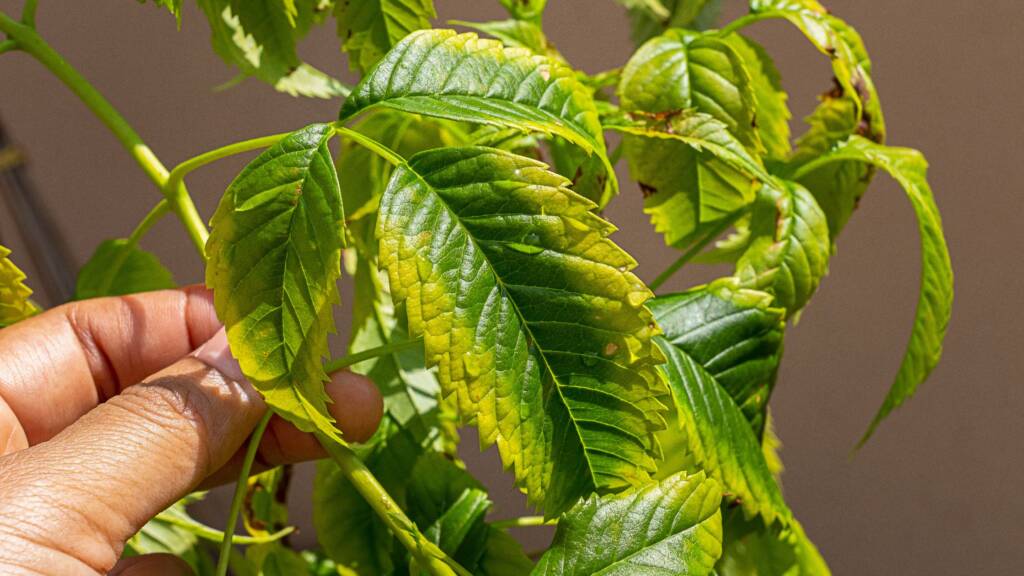
Indoor plants are susceptible to various diseases, often caused by environmental stress, poor care practices, or pathogens like fungi, bacteria, and viruses. Early identification and prompt action can help keep your plants healthy.

1. Root Rot
Cause: Overwatering and poor drainage, leading to fungal growth in the roots.
Symptoms:
- Yellowing or wilting leaves.
- Soft, mushy roots with a foul smell.
- Stunted growth.
Treatment:
- Remove the plant from the pot and inspect roots.
- Trim off all rotted roots with sterilized scissors.
- Repot in fresh, well-draining soil and a pot with drainage holes.
- Water only when the topsoil feels dry.
2. Powdery Mildew
Cause: High humidity and poor air circulation, often from fungal spores.
Symptoms:
- White or gray powdery coating on leaves and stems.
- Leaves may yellow, curl, or fall off.
Treatment:
- Isolate the infected plant.
- Wipe affected leaves with a damp cloth.
- Spray with a mixture of 1 teaspoon baking soda, 1 quart water, and a drop of dish soap.
- Improve air circulation and reduce humidity.
3. Leaf Spot (Fungal or Bacterial)
Cause: Fungal or bacterial infections often triggered by water sitting on leaves.
Symptoms:
- Brown, black, or yellow spots with a distinct border.
- Leaves may drop prematurely.
Treatment:
- Remove infected leaves and discard them.
- Avoid overhead watering; water at the base.
- Apply a fungicide or bactericide as needed.
4. Botrytis (Gray Mold)
- Gray, fuzzy mold on leaves, flowers, or stems.
- Wilting or rotting plant tissue.
Treatment:
Cause: High humidity and cool temperatures encourage fungal growth.
Symptoms:
- Remove affected areas with sterilized tools.
- Reduce humidity and increase air circulation.
- Use a fungicide labeled for gray mold.
5. Blight
Cause: Rapid spread of fungal or bacterial pathogens.
Symptoms:
- Large, irregular brown or black patches on leaves.
- Wilting or sudden collapse of healthy-looking plants.
Treatment:
- Prune affected parts immediately and discard them.
- Use fungicides or bactericides as recommended for the specific pathogen.
- Avoid overcrowding plants to improve airflow.
6. Anthracnose
Cause: Fungus thriving in warm, wet conditions.
Symptoms:
- Dark, sunken spots on leaves, stems, or fruits.
- Leaves may develop holes and fall off.
Treatment:
- Remove infected plant parts.
- Water at the base to avoid wetting leaves.
- Apply a copper-based fungicide.
7. Mosaic Virus
Cause: Viral infection spread by insects like aphids or through contaminated tools.
Symptoms:
- Yellow, white, or light green mosaic-like patterns on leaves.
- Stunted growth and distorted foliage.
Treatment:
- Unfortunately, there is no cure for viral infections.
- Remove and dispose of infected plants.
- Disinfect tools to prevent spread.
- Control insect vectors like aphids.
8. Damping Off
Cause: Fungal infection affecting seedlings in overly moist soil.
Symptoms:
- Seedlings collapse and die soon after sprouting.
- Stems appear thin and water-soaked near the soil line.
Treatment:
- Discard affected seedlings.
- Sterilize pots and use fresh soil.
- Avoid overwatering and ensure good drainage.

9. Sooty Mold
Cause: Fungus growing on honeydew secreted by pests like aphids, mealybugs, or scale insects.
Symptoms:
- Black, sooty coating on leaves and stems.
- Reduced photosynthesis and plant health.
Treatment:
- Control the pest infestation with insecticidal soap or neem oil.
- Gently wipe leaves with a damp cloth to remove the mold.
10. Rust
Cause: Fungal infection in humid conditions.
Symptoms:
- Orange, red, or brown pustules on the underside of leaves.
- Leaves may yellow and drop.
Treatment:
- Remove infected leaves and destroy them.
- Apply a sulfur-based fungicide.
- Improve air circulation and reduce humidity.
Prevention Tips:
- Maintain Good Hygiene:
- Remove dead leaves and debris promptly.
- Sterilize tools and pots before use.
- Water Wisely:
- Avoid overwatering and ensure proper drainage.
- Water at the base, not on leaves.
- Improve Air Circulation:
- Space plants adequately and avoid overcrowding.
- Use fans if necessary.
- Monitor for Pests:
- Inspect plants regularly to catch problems early.
- Treat pest infestations promptly to prevent secondary infections.
- Quarantine New Plants:
- Keep new plants separate for a few weeks to ensure they’re disease-free before introducing them to your collection.
By staying proactive and attentive, you can prevent and manage most diseases, keeping your indoor plants healthy and vibrant! 🌱


